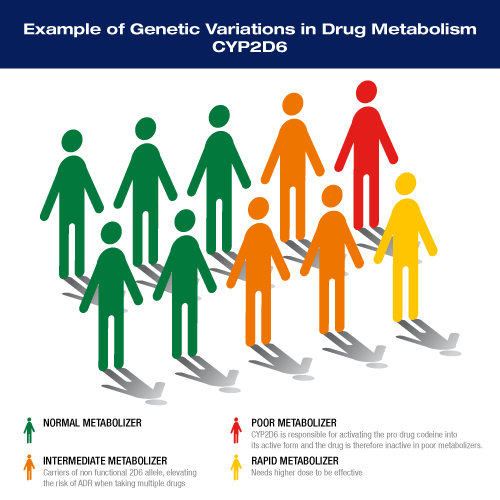STEP 1: Pharmacogenetic Testing
The importance of pharmacogenetic testing cannot be underestimated. The following graph depicts the individual genetic variations of CYP2D6 function/expression in humans. Ethnicity is also a factor, and this graph is a generalization of the variations.
 CYP2D6 is responsible for metabolizing approximately 25% of medications (1.) and is one of the genes that are on the testing panel.
CYP2D6 is responsible for metabolizing approximately 25% of medications (1.) and is one of the genes that are on the testing panel.
The full testing panel available:
FACT V MUTATION FACT 2 MUTATION CYP3A4
CYP3A5 CYP2D6 CYP2C19 CYP2C9 VKORC1
MTHFR 677/1298
After testing, the physician can then assess which drugs are suitable and in what dose. It also enables the physician to identify patients at the start of treatment that do not respond well to the commonly prescribed drugs, and the alternative option, non invasive neuromodulation therapy/ supplements can be prescribed instead. This strategy can help to drastically reduce adverse drug reactions and treatment failure, which in turn reduces risk of medical malpractice claims and most importantly improves patient outcomes in a shorter time frame. This also results in a reduction in the cost of health care to the patient and Medicare or insurance company.
STEP 2: Neurotransmitter Testing
Numerous clinical studies have shown that inadequate neurotransmitter function has a profound influence on overall health and well-being. In fact, imbalances in certain neurotransmitters are associated with most of the prevalent symptoms and conditions seen in practitioners offices today including Mood disorders; depression, anxiety, fatigue, insomnia, loss of mental focus. ADD, ADHD, cognitive fog, addiction and dependency. Identifying and managing neurotransmitter imbalances is facilitated with a noninvasive urinary test. Testing provides a tool to understand each patient’s specific neuroendocrine imbalances, which can be corrected with individualized treatment plans.
The recommended NT panel is:
Serotonin, GABA, Dopamine, Epinephrine, Norepinephrine, Glutamate
This panel is a good tool for monitoring therapeutic interventions of neurotransmitter imbalances previously tested, or when symptoms indicate an imbalance. Includes inhibitory and excitatory neurotransmitters. Simple urine test.
The non invasive neuromodulation devices are excellent, patient centered options that allow the body to create its own biochemistry to treat pain, insomnia, anxiety and depression.
1. Wang B, Yang LP, Zhang XZ, Huang SQ, Bartlam M, Zhou SF (2009). “New insights into the structural characteristics and functional relevance of the human cytochrome P450 2D6 enzyme”. Drug Metab. Rev. 41 (4): 573 643. doi:10.1080/
